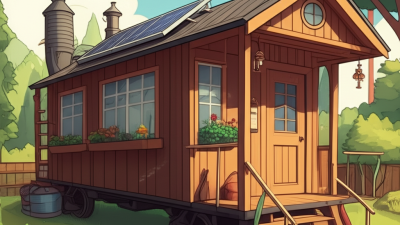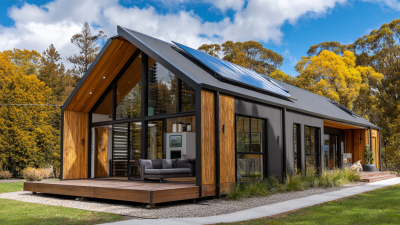The Ultimate Guide to Sustainable Living in Boxcar Homes
As urbanization and environmental concerns intensify, the concept of sustainable living has gained significant traction, particularly in innovative housing solutions like boxcar homes. According to the latest report from the American Institute of Architects, sustainable design practices can reduce energy usage by up to 30%, making it increasingly important to explore eco-friendly housing options. Boxcar homes, often constructed from repurposed materials, exemplify a unique approach to minimalist living that not only minimizes waste but also maximizes efficiency. The U.S. Green Building Council noted that residential buildings account for roughly 20% of the nation’s greenhouse gas emissions, underscoring the urgent need for sustainable alternatives. By integrating energy-efficient technologies and sustainable practices into boxcar home design, homeowners can significantly reduce their environmental footprint while embracing a lifestyle that is both affordable and resilient. This ultimate guide will delve into practical tips and strategies for achieving sustainable living in boxcar homes, enabling you to contribute to a more sustainable future.

Innovative Space-Saving Solutions for Eco-Friendly Design in Boxcar Homes
Boxcar homes offer a unique approach to sustainable living, emphasizing eco-friendly design and minimalistic lifestyles. With space at a premium, innovative space-saving solutions become essential for those looking to maximize functionality while minimizing their ecological footprint. Clever designs can transform compact areas into multifunctional spaces, proving that sustainable living doesn't mean sacrificing comfort or style.
One effective tip for optimizing space in boxcar homes is to incorporate built-in furniture. Features like fold-out beds, wall-mounted desks, and storage benches can seamlessly blend into the home’s architecture, saving space without compromising aesthetics. Additionally, consider utilizing vertical space by installing shelves and cabinets that reach up to the ceiling. This not only provides additional storage but can also create an illusion of height, making the space feel larger.
Another innovative solution involves using collapsible items that can be easily stored away when not in use. Folding chairs, retractable tables, and stackable kitchenware can be incredibly versatile, allowing for a fluid transition between daily activities and gatherings. By prioritizing multifunctionality in design choices, boxcar homeowners can nurture a sustainable lifestyle while fully embracing the charm and efficiency of their unique living space.
The Benefits of Sustainable Living in Boxcar Homes
Essential Renewable Energy Options for Sustainable Living in Boxcar Homes
When it comes to sustainable living in boxcar homes, selecting the right renewable energy options is crucial for minimizing environmental impact while maximizing efficiency. Solar energy remains one of the most popular choices due to its accessibility and decreasing installation costs. Boxcar homes can efficiently harness solar power through strategically placed solar panels, offering a reliable energy source for everyday needs. The compact nature of boxcar homes allows for optimal sunlight exposure, making solar a particularly effective solution for those seeking to power their homes sustainably.
In addition to solar panels, wind turbines are another renewable energy option to consider for boxcar living. Small-scale wind turbines can be installed in suitable locations where wind conditions are favorable. These turbines work effectively to complement solar systems, providing consistent energy generation, especially in areas with variable weather patterns. The combination of solar and wind energy creates a robust energy system that can significantly reduce reliance on fossil fuels and contribute to a more sustainable lifestyle within the unique confines of a boxcar home.
Water Conservation Techniques to Implement in Your Boxcar Lifestyle
Water conservation is essential for sustainable living, especially in boxcar homes where space and resources are limited. According to the U.S. Environmental Protection Agency, the average American household uses about 300 gallons of water per day, and implementing effective water-saving techniques can significantly reduce this number. Boxcar dwellers can adopt strategies such as rainwater harvesting, which allows them to collect and store rainwater for non-potable uses such as irrigation and flushing toilets. This method can reduce household water use by up to 50%, making it a valuable practice for off-grid living.
Another effective technique is the installation of low-flow fixtures. Switching to low-flow showerheads and faucets can cut water usage by about 30%-50%. Additionally, using dual-flush toilets can conserve up to 67% more water compared to traditional single-flush models. Given that nearly 30% of residential water use is attributed to toilet flushing alone, these simple upgrades can lead to substantial savings. By integrating these water conservation methods into their lifestyles, boxcar homeowners can create a more sustainable living environment while contributing to the overall goal of reducing water consumption on a larger scale.
The Ultimate Guide to Sustainable Living in Boxcar Homes - Water Conservation Techniques
| Technique | Description | Estimated Water Savings | Implementation Difficulty |
|---|---|---|---|
| Rainwater Harvesting | Collecting and storing rainwater for irrigation and household use. | Up to 50% of household water usage. | Moderate |
| Greywater Recycling | Reusing water from sinks, showers, and laundry for irrigation. | 30-40% of domestic water use. | Challenging |
| Low-flow Fixtures | Installing low-flow faucets, showerheads, and toilets. | Up to 25% in water savings. | Easy |
| Mulching | Using organic materials to retain soil moisture in gardens. | Reduces water usage by 25-50% in gardens. | Easy |
| Drip Irrigation | Using a drip system to water plants directly at their roots. | Reduces water use by 30-50% compared to traditional methods. | Moderate |
Eco-Friendly Materials for Building and Furnishing Your Boxcar Home
When it comes to building and furnishing your boxcar home, selecting eco-friendly materials is essential for sustainable living. Opting for reclaimed wood not only adds unique character to your space but also minimizes deforestation and reduces waste. Look for local suppliers offering salvaged timber, which can be transformed into stunning flooring, walls, or furniture pieces.
Tips: Consider using bamboo, a fast-growing grass, as an alternative for flooring or cabinetry. It's durable, renewable, and brings a natural warmth to your interiors. Additionally, recycled metal accents can enhance the rustic aesthetic of a boxcar home while contributing to its sustainability.
Another key aspect of furnishing your boxcar is selecting textiles made from organic or recycled materials. Look for cushions, curtains, and rugs crafted from organic cotton, hemp, or upcycled fabric. These options not only provide comfort but also lessen the environmental impact of conventional textile production.
Tips: Thrift shops and local artisans are great resources for finding unique, eco-friendly furnishings. Supporting these businesses fosters sustainability within your community while allowing you to personalize your boxcar home with one-of-a-kind pieces.
Practical Tips for Growing Your Own Food in Limited Boxcar Space
Living sustainably in a boxcar home presents unique challenges, especially when it comes to growing your own food in a limited space. However, with careful planning and the right techniques, you can cultivate a thriving mini-garden.
One effective tip for maximizing your limited space is to use vertical gardening methods. By installing shelves or using wall-mounted planters, you can grow herbs, small vegetables, and even flowers without taking up valuable floor space. This method not only allows you to grow more plants but also enhances the aesthetics of your boxcar home.
Another practical approach is to focus on container gardening. Select lightweight, portable containers that can fit on windowsills or hang from hooks. Opt for compact plant varieties such as dwarf tomatoes or salad greens. Ensure that these containers have adequate drainage, and consider using a quality potting mix enriched with organic matter to boost plant growth. Regularly check moisture levels and use a drip irrigation system to conserve water while ensuring your plants thrive.
